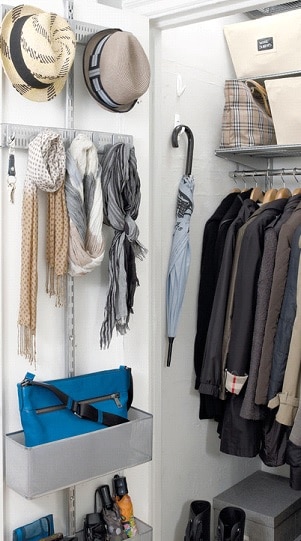Many front hall closets are also considered coat closets and offer little depth. These closets typically are straightforward to design with all the organizational components facing forward. However, for deeper closets, a walk-in closet system can be installed that dramatically expands design options. Just a little more depth allows you to separate inventories better by arranging certain organizational components on different walls. For instance, a deep-enough side wall can hold hanging rods or shelves. Then the back wall can store another organizational component, such as shelves for storing another category like shoes. A deeper closet offers many arrangement options, so it’s important to look at all the possibilities when designing these spaces.
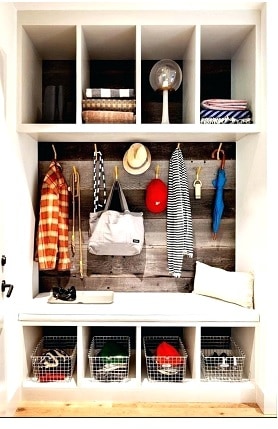
The front hall closet is often typically are straightforward to design with all the organizational components facing forward. However, for deeper closets, a walk-in closet system can be installed that dramatically expands design options. Just a little more depth allows you to separate inventories better by arranging certain organizational components on different walls. For instance, a deep-enough side wall can hold hanging rods or shelves. Then the back wall can store another organizational component, such as shelves for storing another category like shoes. A deeper closet offers many arrangement options, so it’s important to look at all the possibilities when designing these spaces. The front hall closet is often times overstuffed with many odds and ends, but outerwear, footwear, gloves, scarves, and hats take storage precedence in the front hall closet. It needs to be decluttered a few times a year, especially between seasons. You may need to clear an area around the closet, such as an entry hall, to place belongings while you sort and downsize. Have bags or boxes ready for off-season, sale, trash, recycle, donation, and items to transfer elsewhere.
When your coat closet is filled to the brim, you may need to seek alternative locations for some of the items. In such cases, determine which things can logically go elsewhere. For example, shoes, hats, and gloves can be separated by individual household members and placed in their individual bedrooms. You should also look just outside the closet door to create places to store items that are traditionally placed in a coat closet. A foyer chest, bench, armoire, dresser, or wall organizer can hold countless items. Leaving a front hall closet half full to save room for guest coats is an antiquated concept. A portable coatrack that can be broken down and stored away is good for guests’ outerwear and can also be repurposed as a garment rack for a garage sale. This way, you can make permanent use of your closet space all year long.
Organizing the Front Hall Closet
Start by first emptying out all the contents currently in the front hall closet. Next, sort belongings into like groups and then split the pile by household member. For example, place all your winter coats in a pile and then subdivide them by a family member. This is important to do since you may need to console some individuals about reducing their things. Downsize any inventories you have control over first; those that need another person can be placed aside until they’re ready to help. You want to establish rules to control closet clutter. For example, allow no more than two in-season jackets, gloves, hats, scarves, shoes, boots, and the like per person. Plan to remove the excess by relocating, donating, selling, and so on. Now is the time to make good decisions about what should stay in the front hall closet and what should be relocated. Even if the front hall closet has room for certain items, it still may be better to move certain items into other closets, rooms, or different home entry points if they’re the more convenient places for easy access. If not already in place, begin a system so off-season articles are removed from the coat closet and held at another location. You should have a set of storage containers labeled off-season coat closet or labeled with the name of the articles.
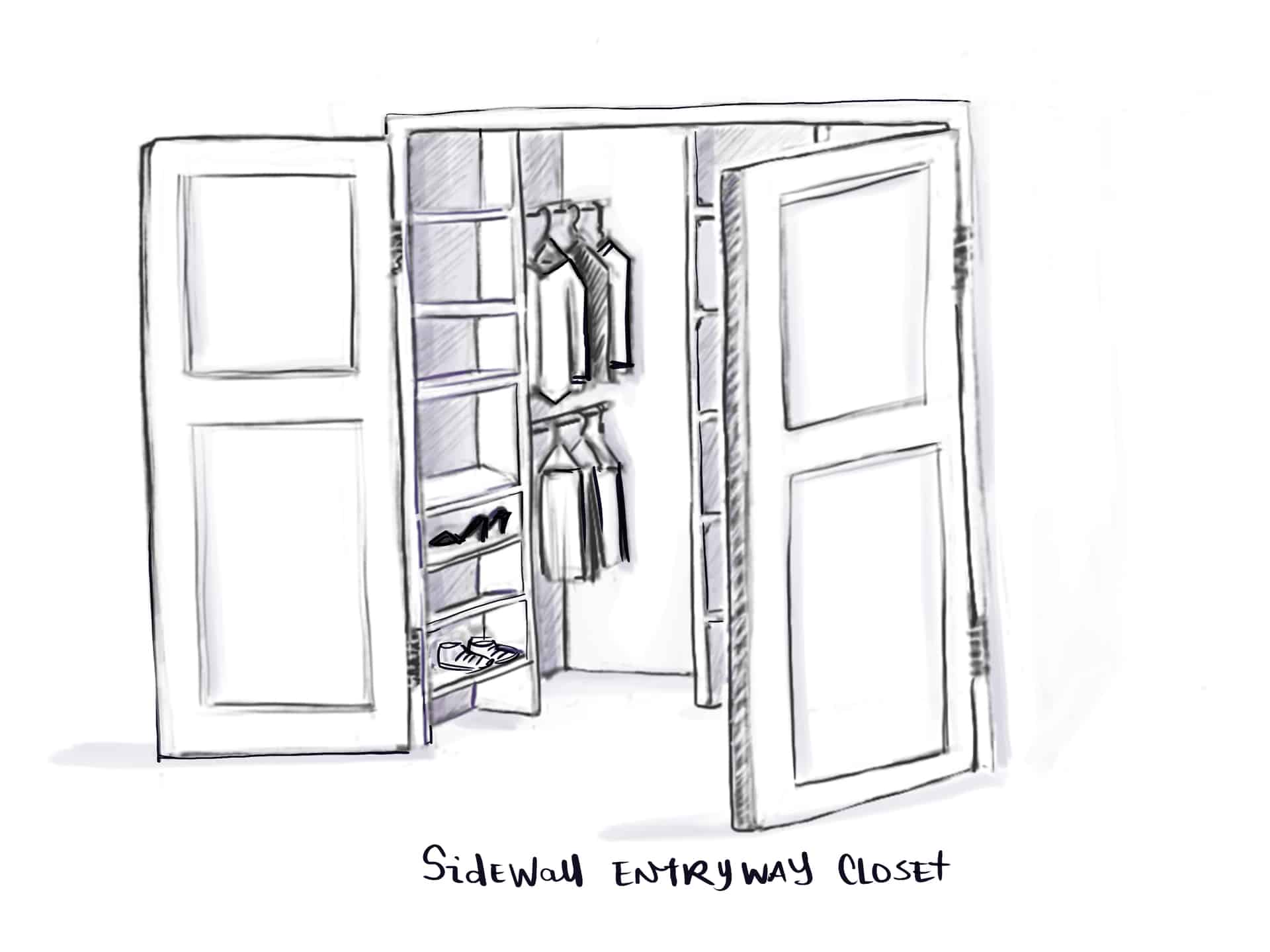
Downsizing Outerwear, Footwear, and Accessories
When downsizing wearable items like coats, hats, gloves, and shoes, look them over closely to ensure sure all buttons are present and not loose. Test zippers and snaps. Check for stains, rips, and tears. On footwear, look over both heels and soles. Generally, wearable items that are in good condition but have not been worn in the past two years are likely to never be worn. Find out why the item is not worn and see if it’s correctable. Perhaps a minor detail, like changing the buttons, is in order. This is your opportunity to take charge and fix the problem, rather than procrastinating. If the work or expense is too much effort for the return, it’s time to donate or sell the items. Bag all articles that need special attention like fur storage, shoe repair, and cleaning. Make sure that you really want to keep things before making the effort to preserve or properly care for them, because doing so is time-consuming and expensive. Have household members choose the coats and shoes they want hanging in the front hall closet. Again, limited to only a few coats, shoes, and so on per person. You should end your decluttering session with bags of items to donate, sell, repair, alter, and clean on their way to their next destination. For example, donation bags should be loaded in the car or a call should have been made for a pickup. Items to sell should be boxed, labeled, and placed in a designated storage place for them.
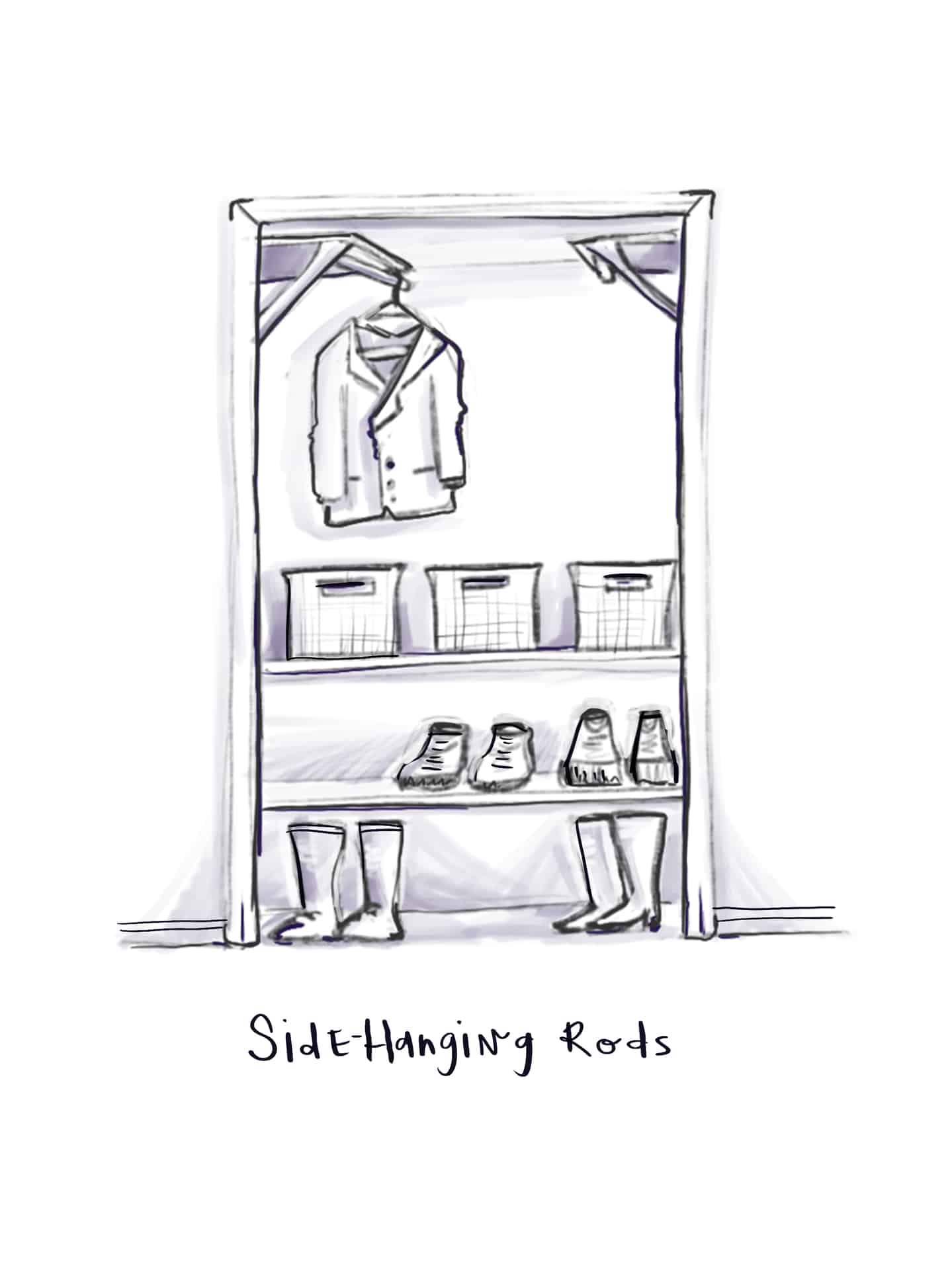
Outerwear Storage
Most outerwear should be hung on a rod for jackets and coats to maintain their shape. However, it may be more convenient to use hooks for children’s jackets so they’re more easily accessible. Over-the door or door-mounted coatracks with hooks can also be used. These organizers free up valuable hanging-rod space. Double-hung hanging rods are perfect for closets short on space. However, there should also be enough room to have a rod for long coats. In very shallow front closets, hanging rods can be mounted on the sides of the closet, perpendicular to the door and facing each other, instead of the conventional way. This is a good solution when thick coats and jackets don’t clear a closed door.
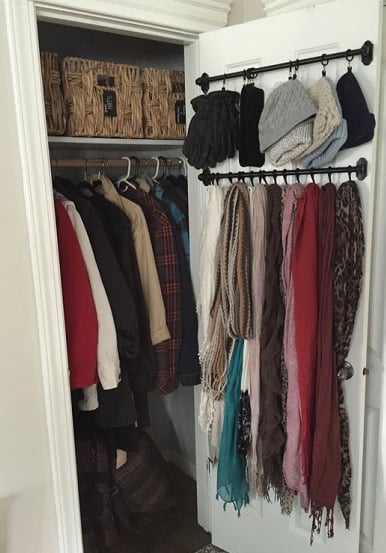
Footwear Storage
The most important thing to accomplish with footwear storage design is not to end up storing any loose shoes on the floor, no matter how well they’re initially lined up. Inevitably, the order will be lost, and the closet floor will become a mess. Footwear can be stored in a number of organizers. All closet systems have footwear storage components, such as slanted shelving, pullout shoe racks, and cubby organizers. These footwear organizers are best placed at eye level and below, so everything is easy to see and reach. The most common footwear organizers to add to an existing closet are shoe-cubby pocket organizers that suspend from a hanging rod. However, these organizers are prone to sag when weighted down with too many shoes, so keep loads light. These organizers are commonly found in canvas, but they’re made in plastic, as well, for easier cleaning. Make sure that you are still able to share the hanging-rod space, so jackets and coats can move freely. Door-mounted or over-the-door shoe organizers free closet space. Door organizers that use wire arch-shaped loops in the shape of a shoe or upright prongs to secure footwear are stable and vent the footwear. Over-the-door pocketed shoe organizers tend to have tighter pockets, making them suitable only for slim footwear. Freestanding cubby or tiered-shelf shoe organizers designed for floor storage come in many sizes and materials. Some are even movable and have casters for optimal access. Be careful when selecting cubby organizers, because they’re generally not adjustable and many have small compartments that cannot fit boots or even chunky shoes. The bottom shelf of a floor-based shoe organizer should almost touch the ground so you are not wasting any space. Doing so will cover the floor and avoid the chance that shoes wind up lying on the ground, which leads to disorder. Scarves, Hats, and Gloves Gather all outwear accessories throughout the home and sort them into different groups, such as dress gloves, ski gloves, fleece gloves, mittens, ear muffs, ski hats, headbands, scarves, and so on. Match up pairs of gloves or mittens. Place single gloves missing their mates in the same place you keep single socks that are not paired. Pin a note with the current date to the glove or mitten so you are able to keep track of how much time passes, so you’re not keeping them forever. Discard such socks or gloves in a month’s time after making an earnest search for the mate. Check your outerwear accessories for rips, stains, and wear. Anything outgrown or not worn in the past two seasons should be donated or sold. Each household member may need two pairs of casual hats, gloves, and scarves. It may be necessary to have a number of pairs of each to accommodate extensive collections of outerwear involving many colors, but think conservatively and stick with what is actually worn. Additionally, dress or work outerwear accessories, or both, may require another set. Outerwear accessories can be divided and stored in separate bins, containers, or baskets. Each group can store a single person’s accessories or hold a separate category like gloves. Label containers with their contents. Use glove clips to keep pairs together in a storage container so they’re easy to locate. Over-the-door or wall-mounted clear, pocketed organizers easily divide individual pairs of gloves and keep them visible and accessible. Towel bars mounted onto the backside of a closet door can hold gloves and hats with rod clips. Scarves can hang over rods tied in place.
